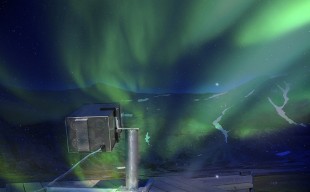
Birkelandforelesningen og utdeling av Yaras Birkelandspris
- Forelesningen er åpen for alle interesserte.
- Gratis.
- Ingen påmelding.
Forelesning og utdeling av Yaras Birkelandspris for 2014. Årets Birkelandforeleser Jean Lilensten er en pionér innen forskning på romvær.
I sin forelesning på Det Norske Videnskaps-Akademi 25. september tar han oss med ut i verdensrommet, en reise som vil gi oss ny innsikt om hvordan kunnskap om romvær også kan ha betydning for livet på jorda. Studier av nordlyset står sentralt her. Og Lilensten kan også fortelle om en fransk-norsk oppdagelse.
Dr. Jean Lilensten. Foto: Europlanet
Birkelandsforelesningen 2014 har tittel: A New Window on our Space Environment: The Polarization of the Auroral Emissions. A French-Norwegian Discovery.
Forskning, innovasjon og pris
I 2012 ble det innført en ekstraforelesning før selve Birkelandforelesningen der temaet skal være forskning og utvikling, altså helt i Kristian Birkelands ånd. I år holdes denne forelesningen av Rune Ingels, N2 Applied AS. Temaet for hans foredrag er "Innovation and nitrogen technology development".
I forbindelse med Birkelandforelesningen blir Yaras Birkelandpris delt ut. Prisen går til en PhD-kandidat fra et norsk universitet og utdeles annethvert år i fysikk og kjemi. I år går prisen på 100.000 kroner til en fysiker.
Birkelandforelesningen:
Dr. Jean Lilensten, Institut de Planétologie et d'Astrophysique de Grenoble, CNRS, Université Joseph Fourier, France:
- A new window on our space environment: The polarization of the auroral emissions.
A French - Norwegian discovery

The "Spectro Photo Polarimeter" was built to perform polarization measurement of auroral emissions.
Auroras are not only one of the most munificent shows at the Earth. They are also the most spectacular effect of the relations between the solar wind and our space environment. Looking at auroras, one may feel astonished. Understanding them gives an additional feeling: that of the physical connection to the cosmos. Measuring the auroras is therefore a fantastic way to access parameters that are almost impossible to monitor in space. The stratospheric balloons do not go high enough while the satellites fly above this atmospheric layer.
Why should we measure the upper atmosphere? First of all because mankind thirsts for knowledge. But it turns out that this is also important for our modern societies: telecommunications between the Earth and spacecraft, and even between the spacecraft themselves, cross this layer. There are also many other applications, all gathered in a new discipline called "Space Weather".
A few years ago, we realized that the intensities of the red and green auroral lights are not sufficient to know the upper atmosphere parameters. The idea came up: could these emissions be polarized?
Polarized? We are all used to polarization of waves nowadays because it is the technique for making us see 3D movies. We wear glasses that are polarized and the screen has two images with different polarization. Our brain reconstructs a 3D image.
In the case of the auroras, the source of the polarization, which is the solar wind entering the atmosphere along the magnetic field, is quite different, but the result is the same. In cooperation with colleagues at the University of Oslo, an instrument able to perform polarization measurement of auroral emissions, the "Spectro Photo Polarimeter", was built.
For physical reasons, we knew that the green light should not be polarized. However, the conditions to observe it could be present in Svalbard. This is where we discovered it: we published the article in 2008.
The polarization not only helps us understanding the upper atmosphere. It also allows us to actually "see" the magnetic configuration. This is a way to figure out how the magnetic field of the Sun wraps Venus or Mars, for example. We also realized that measurements of the polarization of such large scale features as an aurora allow to retrieve microscopic atomic parameters that otherwise are impossible to measure. Polarization could be a main feature of the Universe. We already discovered it in the upper atmosphere of Jupiter...